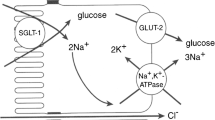Abstract
Improvements in characteristics of solutions used for oral rehydration therapy, to provide significant reductions in amount and duration of diarrhea, are expected to contribute to wider use of these fluids. Recent studies suggest that these may come about from reducing the osmolality of the solution, and by providing short chain fatty acids for better fluid absorption from the colon. This article briefly reviews the physiology of intestinal and colonic absorption in diarrhea, and indicates the further studies that are needed to translate the above advances into universal practice for the treatment of diarrhea.
Similar content being viewed by others
References
World Health Organization.The world health report. WHO, Geneva, Switzerland. 1999.
Greenough WB III. A simple solution.J Diarrhoeal Dis Res 1993; 11: 1–5.
Reis EC, Goepp JG, Katz S, Santosham M. Barriers to use of oral rehydration therapy.Pediatrics 1994; 93: 708–711.
Desjeux JF, Briend A, Butzner JD. Oral rehydration solution in the year 2000: Pathophysiology, efficacy and effectiveness.Bailliere’s Clin Gastroenterol 1997; 11: 509–527.
Thillainayagam AV, Hunt JB, Earthing MJG. Enhancing clinical efficacy of oral rehydration therapy: Is low osmolality the key?Gastroenterology 1998; 114 : 197–210.
Bhan MK, Mahalanabis D, Fontaine O, Pierce NF. Clinical trials of improved oral rehydration salt formulations: a review.Bull World Health Organ 1994; 72: 945–955.
Duggan C. Glutamine-based oral rehydration solutions: The magic bullet revisited?J Pediatr Gastroenterol Nutr 1998; 26 : 533–535.
Fontaine O, Gore SM, Pierce NF. Rice-based oral rehydration solution for treating diarrhoea.Cochrane Database Syst Rev 2000; 2 CD001264.
International Study Group on reduced osmolarity ORS solutions. Multicentre evaluation of reduced osmolarity oral rehydration salts solution.Lancet 1995; 345: 282–285.
Szajewska, Hoekstra JH, Sandhu Bet al. Management of acute gastroenteritis in Europe and the impact of the new recommendations.J Pediatr Gastroenterol Nutr 2000; 30: 522–527.
Alam NH, Majumder RN, Fuchs GJ, CHOICE Study Group. Efficacy and safety of oral rehydration solution with reduced osmolarity in adults with cholera: a randomised double-blind clinical trial.Lancet 1999; 354 : 296–299.
Read NW. Diarrhoea: the failure of colonic salvage.Lancet 1982; 2 : 481–483.
Ramakrishna BS, Nance SH, Roberts-Thomson IC, Roediger WEW. The effect of enterotoxins and short chain fatty acids on water and electrolyte fluxes in ileal and colonic loops in vivo in the rat.Digestion 1990; 45: 93–101.
Krishnan S, Ramakrishna BS, Binder HJ. Stimulation of sodium chloride absorption from secreting rat colon by short chain fatty acids.Dig Dis Sci 1999; 44: 1924–1930.
Dagher PC, Egnor RW, Taglietta-Kohlbrecher A, Charney AN. Short-chain fatty acids inhibit cAMP-mediated chloride secretion in rat colon.Am JPhysiol 1997; 271: C1853–60.
Ramakrishna BS, Mathan VI. Colonic dysfunction in acute diarrhoea: the role of short chain fatty acids.Gut 1993; 34 : 1215–1218.
Ramakrishna BS, Selvi K, Srinivasan P, Mathan VI, Binder HJ. Fermentation of starchin vitro in human cholera: Implications for therapy.Gastroenterology 1994; 106: A264 (abstract).
Ramakrishna BS, Venkataraman S, Srinivasan P, Dash P, Young GP, Binder HJ. Amylase-resistant starch plus oral rehydration solution for cholera.N Engl J Med 2000; 342: 308–313.
Brown I. Complex carbohydrates and resistant starch.Nutr Res 1996; 54: S115-S119.
Argenzio RA, Moon HW, Kemeny LJ, Whipp SC. Colonic compensation in transmissible gastroenteritis of swine.Gastroenterology 1984; 86: 1501–1509.
Teichberg S, Wingertzahn MA, Moyse J, Wapnir RA. Effect of gum arabic in an oral rehydration solution on recovery from diarrhea in rats.J Pediatr Gastroenterol Nutr 1999; 29: 411–417.
Bowling TE, Raimundo AH, Grimble GK, Silk DB. Reversal by short-chain fatty acids of colonic fluid secretion induced by enteral feeding.Lancet 1993; 342: 1266–1268.
Alvarez JO, Salazar-Lindo E, Kohatsu J, Miranda P, Stephensen CB. Urinary excretion of retinol in children with acute diarrhea.Am J Clin Nutr 1995; 616: 1273–1276.
Anonymous. Zinc and copper wastage during acute diarrhea.Nutr Rev 1990; 48 :19–22.
Bhan MK, Bhandari N. The role of zinc and vitamin A in persistent diarrhea among infants and young children.J Pediatr Gastroenterol Nutr 1998; 26: 446–453.
Author information
Authors and Affiliations
Corresponding author
Rights and permissions
About this article
Cite this article
Ramakrishna, B.S. Towards a better oral rehydration fluid. Indian J Pediatr 68, 41–43 (2001). https://doi.org/10.1007/BF02728856
Issue Date:
DOI: https://doi.org/10.1007/BF02728856




